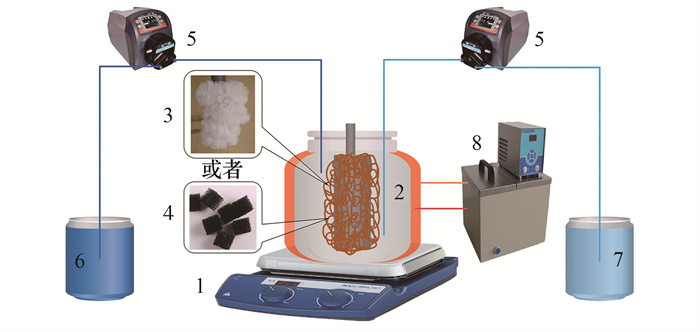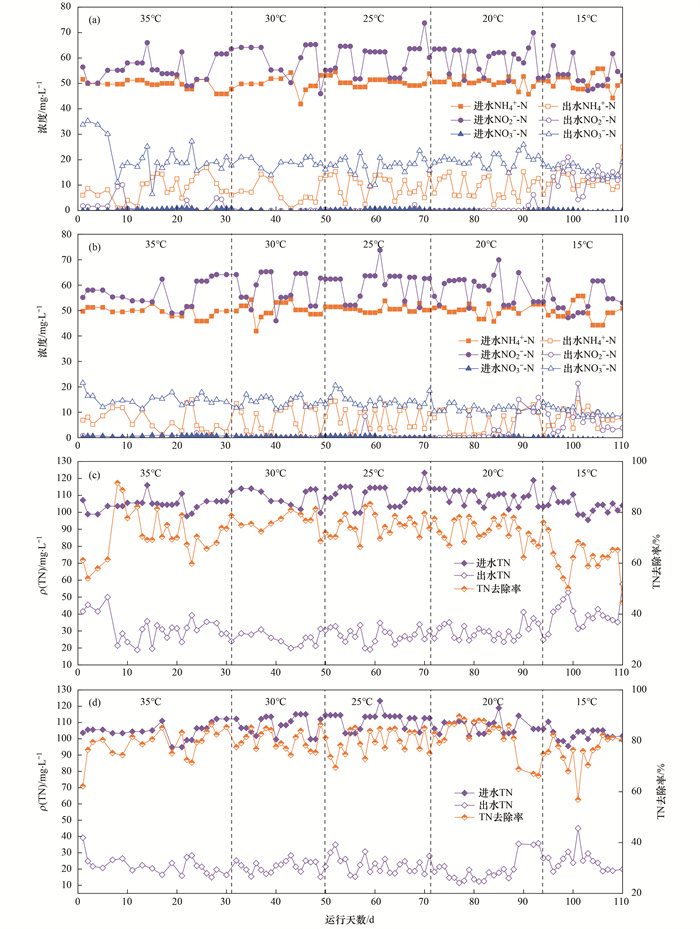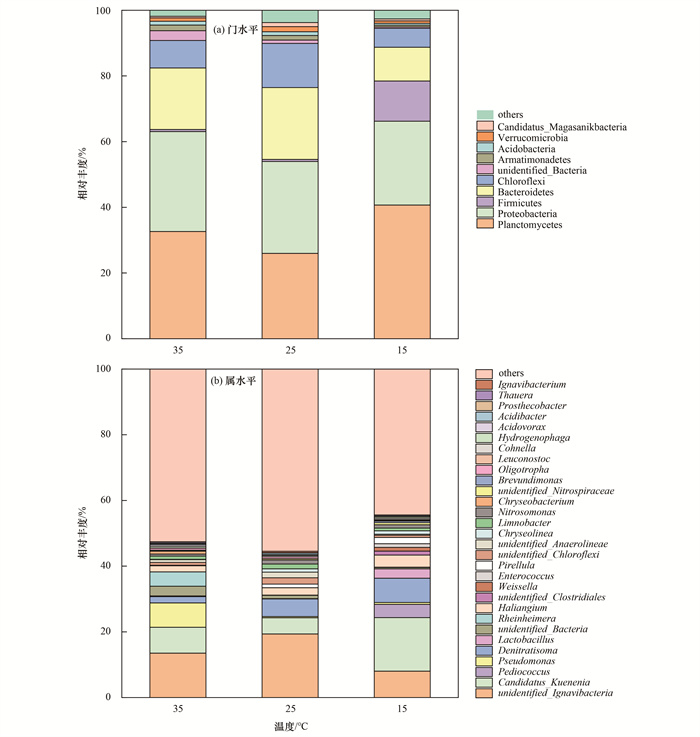2. 济南城建集团有限公司, 济南 250031
2. Ji'nan Urban Construction Group Co., Ltd., Ji'nan 250031, China
厌氧氨氧化(anaerobic ammonium oxidation, ANAMMOX)工艺具有高效节能、污泥产量少和无需外加碳源等显著优势, 适用于高氨氮废水处理, 如垃圾渗滤液[1]、消化废水[2]和养殖沼液[3]等.但是ANAMMOX工艺的实际应用受限于ANAMMOX菌难以富集, 其倍增时间长[4], 细胞产率低[5].为强化ANAMMOX菌的富集, 减少污泥流失, 可利用填料的截留作用, 构建ANAMMOX生物膜系统[6], 有助于工艺启动.
ANAMMOX生物膜反应器填料包括: 火山岩[7]、沸石[8]、活性炭[9]、聚氨酯海绵[10]、无纺布[11]和聚乙烯填料[12]等.Wang等[13]的研究运行无纺布固定床反应器, 经39 d完成ANAMMOX启动, 367 d达到最大氮处理负荷10.3 kg ·(m3 ·d)-1, TN去除率90%.王钧等[14]的研究以聚氨酯海绵作为ANAMMOX生物膜载体, 经过73 d成功启动反应器; 稳定运行时, 总无机氮去除率达到87.97%.
温度是影响ANAMMOX生物膜工艺运行的重要因素.有研究发现, ANAMMOX菌在10~55℃均有活性[15, 16], 最适温度30~40℃[17, 18].曾涛涛[19]的研究考察了火山岩ANAMMOX生物膜反应器常温下的脱氮效果, 结果表明15℃下, 进水氨氮ρ(NH4+-N)为190 mg ·L-1, 进水氮容积负荷(NLR)为3.4~4.2 kg ·(m3 ·d)-1, 总氮(TN)去除率为42% ~55%; 当温度升高至20~23℃, 进水ρ(NH4+-N)为46~78 mg ·L-1, NLR为2.9~3.2 kg ·(m3 ·d)-1时, TN去除率可明显提高至75%左右.
如何实现常低温下ANAMMOX稳定脱氮是目前ANAMMOX工艺实际应用面临的问题.本文探讨了不同温度(35~15℃)条件下, 无纺布与改性聚氨酯泡沫塑料填料(改性聚氨酯填料)序批式生物膜反应器(sequence batch biofilm reactor, SBBR)的脱氮效果和微生物群落变化, 以期为ANAMMOX的实际应用提供基础.
1 材料与方法 1.1 试验装置SBBR试验装置如图 1所示.双层反应器内层直径80 mm, 高240 mm, 有效容积2 L; 外层与恒温水浴锅相连, 控制内层反应温度.反应器用锡纸包裹以避免光照.

|
1.磁力搅拌器, 2.双层反应器, 3.无纺布填料, 4.改性聚氨酯填料, 5.蠕动泵, 6.进水桶, 7.出水桶, 8.恒温水浴锅 图 1 ANAMMOX生物膜反应装置流程 Fig. 1 Schematic diagram of ANAMMOX biofilm reactor |
两组反应器分别采用无纺布填料和改性聚氨酯填料, 填充比40%.无纺布填料材质为聚丙烯, 购自深圳市昌泰无纺布有限公司.将无纺布裁剪为约7 cm宽的条状, 然后将无纺布条缠绕在反应器中央的填料棒上, 细线扎紧固定.
改性聚氨酯填料为网状聚氨酯泡沫塑料(购自江苏艾勤环保科技有限公司), 将其切割为1.0 cm3正方体块备用; 采用低温等离子体技术对填料进行表面改性处理[20].用细线将填料块穿起并缠绕固定在反应器中央的填料棒上.
1.2 进水水质进水成分主要包括: ρ[(NH4)2SO4] 236 mg ·L-1, ρ(NaNO2) 296 mg ·L-1, ρ(MgSO4 ·7H2 O) 300 mg ·L-1, ρ(NaHCO3)为500 mg ·L-1, ρ(CaCl2 ·2H2 O)为150 mg ·L-1, ρ(KH2PO4)为30 mg ·L-1; 微量元素Ⅰ和微量元素Ⅱ[21]各1 mL ·L-1.采用(1+9) HCl调节pH为7.5~7.8; 为保持厌氧条件, 进水曝高纯N2 15 min, 使反应器内DO降至0.3 mg ·L-1以下.
1.3 SBBR工艺启动与运行 1.3.1 接种污泥无纺布和改性聚氨酯填料反应器均接种ANAMMOX污泥, 接种污泥浓度为4 000 mg ·L-1, 进行挂膜.接种污泥取自1 m3的SBR反应器, 该反应器在25~30℃条件下运行, 水力停留时间16 h, 进水ρ(TN)为500~800 mg ·L-1, 出水ρ(TN)低于50 mg ·L-1, TN去除率在90%以上.
1.3.2 SBBR工艺启动启动期, 控制恒温35℃, 启动ANAMMOX生物膜反应器. 两反应器的进水NLR为110 mg ·(L ·d)-1, 其中ρ(NH4+-N)为50 mg ·L-1, ρ(NO2--N)为60 mg ·L-1.试验运行周期为24 h: 进水15 min, 反应时间23 h, 静沉30 min, 排水15 min; 排水比90%.稳定运行时, 无纺布填料反应器的TN去除率长期处于60% ~85%; 改性聚氨酯填料反应器的TN去除率基本保持在80%以上.
1.3.3 运行对已经成功启动并稳定运行一个月的无纺布填料和改性聚氨酯填料反应器进行降温试验, 共5个阶段, 温度梯度设置为35、30、25、20和15℃, 每个温度条件下运行20~25 d.温度变化时, 分两次降温: 第一次降温3℃, 稳定3 d后, 再降温2℃至所需温度.
1.4 分析项目与检测方法 1.4.1 常规氮指标检测每个试验运行周期结束时, 取水样测定氮指标.NH4+-N、NO2--N和NO3--N均采用国家标准方法检测[22], TN为NH4+-N、NO2--N和NO3--N三者之和; pH和DO分别采用便携式pH计(Jenco, 6010M, USA)和便携式溶解氧仪(Hach, HQ30d, USA)测定.
1.4.2 微生物群落结构和多样性分析方法(1) DNA的提取在35、25和15℃稳定运行期间, 剪取适量改性聚氨酯生物膜填料, 与反应器出水一同置于50 mL离心管中, 保证填料被浸没.用多管振荡仪振荡10 min至生物膜充分脱落.将泥水混合物在转速3 000 r ·min-1下离心3 min, 弃去上清液, 保留泥样提取DNA.采用土壤DNA提取试剂盒(Omega Bio-Tek, Inc., Norcross, GA, USA)提取微生物基因组DNA.
(2) 高通量测序对提取出的DNA进行qPCR检测.对所扩增的16S rRNA中的V3-V4区域, 进行小片段基因文库的构建, 并基于Illumina HiSeq测序平台对该文库进行双末端测序.经过Reads拼接过滤, 对所有样本的有效数据(effective tags), 以97%的一致性(identity)进行OTUs(operational taxonomic units)聚类, 然后对OTUs的序列进行物种注释丰度分析, 揭示样本的物种组成和群落结构的差异.
2 结果与讨论 2.1 不同温度下ANAMMOX生物膜工艺的脱氮效果不同温度条件下, 无纺布和改性聚氨酯泡沫塑料填料反应器进出水ρ(NH4+-N)、ρ(NO2--N)、ρ(NO3--N)、ρ(TN)和TN去除率见图 2, 化学计量系数变化如图 3所示.

|
(a)和(c)无纺布填料, (b)和(d)改性聚氨酯填料 图 2 不同温度下不同填料反应器中含氮化合物的浓度及去除率 Fig. 2 Nitrogen species concentrations and nitrogen removal efficiency of systems with different carriers at various temperatures |

|
图 3 不同温度下不同填料反应器的化学计量系数 Fig. 3 Values of stoichiometric ratio of systems with different carriers at various temperatures |
进水ρ(TN)为110 mg ·L-1[ρ(NH4+-N)为50 mg ·L-1和ρ(NO2--N)为60 mg ·L-1]时, 在35、30、25、20和15℃运行期间, 无纺布填料反应器TN平均去除率分别为71.16%、76.19%、75.15%、72.68%和61.11%, 而改性聚氨酯填料反应器TN平均去除率分别为78.71%、80.16%、79.78%、81.75%和75.68%.
在降温过程中, 无纺布填料反应器TN去除率在30℃时达到最大值76.19%, 在35~20℃条件下均保持70%以上的TN去除率, 平均ΔNO2--N ∶ΔNH4+-N在1.34~1.45之间, 平均ΔNO3--N ∶ΔNH4+-N在0.42~0.51之间; 降温至15℃时, TN去除率降低至61.11%, 平均ΔNO2--N ∶ΔNH4+-N降至1.09, 低于ANAMMOX反应理论值1.32, 平均ΔNO3--N ∶ΔNH4+-N降至0.41, 但仍高于ANAMMOX反应理论值0.26[23].化学计量系数与ANAMMOX反应理论值的偏差说明反应器中还存在其他氮转化的反应[24].ΔNO2--N ∶ΔNH4+-N偏高说明系统中存在反硝化反应, 偏低可能是由于硝化过程中的氨氧化或短程反硝化反应; ΔNO3--N ∶ΔNH4+-N偏高说明有硝化反应中的亚硝酸盐氧化过程发生, 偏低说明有全程或短程反硝化反应.可以看出, 随着温度降低, 无纺布填料反应器中的硝化反应增强, 反硝化反应减弱.改性聚氨酯填料反应器在35~20℃条件下, TN去除率均保持80%左右; 降温至15℃时, TN去除率降至75.68%, 平均ΔNO2--N ∶ΔNH4+-N从1.23~1.41降至1.16, 平均ΔNO3--N ∶ΔNH4+-N从0.28~0.33降至0.24; 降温过程中, 氨氧化和反硝化反应增强, 亚硝酸盐氧化减弱.
这一现象与李祥等[25]的研究结果相似: 温度在26~37℃时, ANAMMOX生物膜反应器氮去除速率在1.51~1.84 kg ·(m3 ·d)-1之间, 变化幅度4.35%, 当温度低于20℃时, 去除速率快速下降, 尤其当温度低于15℃时, 氮去除速率下降至0.55 kg ·(m3 ·d)-1, 同时出现大量NO2--N积累.宋成康等[26]实验运行SBR反应器, 在20~33℃可稳定ANAMMOX脱氮, 其中TN去除负荷稳定在0.4 g ·(L ·d)-1左右; 但当温度为15℃时, 出现NO2--N积累.温度降低导致厌氧氨氧化活性下降和活化能提高[26, 27], 使ANAMMOX脱氮效率下降.
在相同温度条件下, 与无纺布填料反应器相比, 改性聚氨酯填料反应器TN去除率更高, 化学计量系数更接近ANAMMOX理论值; 在降温过程中, 改性聚氨酯填料反应器TN去除率的下降幅度更小.可以看出, 改性聚氨酯填料相对于无纺布填料能够达到更好的脱氮效果, 同时对低温适应能力更强.这可能是因为改性聚氨酯填料的多孔结构更易形成并维持厌氧环境, 从而更有利于ANAMMOX反应.因此, 改性聚氨酯填料可以作为ANAMMOX生物膜工艺的优选填料; 同时改性聚氨酯填料反应器75%以上的TN去除率也说明ANAMMOX生物膜工艺具有常低温下处理废水的潜力.
2.2 35、25和15℃条件下改性聚氨酯填料生物膜菌群分析选取脱氮效果较好的改性聚氨酯填料反应器, 分别在35、25和15℃稳定运行期间取3个平行泥样, 检测其微生物群落的变化.
2.2.1 基于门水平的微生物群落分布采用MiSeq高通量测序技术分析微生物的特异性DNA片段, 根据OTUs序列的物种注释结果对菌群进行结构组成分析, 得到不同温度条件下改性聚氨酯填料生物膜在门水平上的物种相对丰度如图 4(a)所示.

|
图 4 运行温度为35、25和15℃时, 改性聚氨酯填料生物膜菌群基于门水平和属水平上的物种相对丰度 Fig. 4 Composition of microbial community of the modified polyurethane foam biofilm at the phylum, and at genus levels at 35, 25, and 15℃ |
结果表明, 改性聚氨酯填料反应器中的主要微生物菌群包括浮霉菌门(Planctomycetes)、变形菌门(Proteobacteria)、厚壁菌门(Firmicutes)、绿弯菌门(Chloroflexi)、拟杆菌门(Bacteroidetes)和酸杆菌门(Acidobacteria)等.ANAMMOX菌所属的浮霉菌门(Planctomycetes), 在35、25和15℃的污泥样品中分别占33%、26%和41%, 相对丰度最高.除此之外, 变形菌门(Proteobacteria)、拟杆菌门(Bacteroidetes)和绿弯菌门(Chloroflexi)在3个温度条件下的相对丰度也较高, 分别占30%、19%和8%(35℃), 28%、22%和13%(25℃), 26%、10%和6%(15℃).这几类相对丰度较高的细菌与ANAMMOX菌之间存在协同和竞争关系, 同时得到富集, 成为系统中的优势微生物.
2.2.2 基于属水平的微生物群落分布由图 4(b)可知, 35℃和25℃下ANAMMOX菌属Candidatus Kuenenia的相对丰度分别为8%和5%, 而15℃条件下, Candidatus Kuenenia的相对丰度达到16%, 说明温度降低没有对功能菌的富集产生影响.从35℃到25℃功能菌相对丰度下降可能是因为短期内温度的下降对ANAMMOX菌活性产生了影响, 导致增殖速度减缓, 但由于Candidatus Kuenenia对20℃以下环境温度的良好适应性[28, 29], 很快恢复了活性, 实现了增殖, 在15℃达到相对丰度最大值16%.降温过程对ANAMMOX菌利用基质的影响大于对增殖的影响, 因此, 15℃条件下虽然功能菌的丰度达到最大, 但是脱氮能力弱于25℃和35℃条件下的脱氮能力.
Pseudomonas、Denitratisoma和Thauera等多个具有反硝化作用的属也在反应器中共存[30, 31].其中Pseudomonas和Denitratisoma的相对丰度较高, 在不同温度条件下的相对丰度分别为7.4%和1.9%(35℃)、3.4%和5.4%(25℃)、5.6%和7.4%(15℃).与Candidatus Kuenenia类似, 反硝化菌属Pseudomonas在降温过程中出现了先适应, 后恢复并增殖的现象. Denitratisoma则比较适应低温的环境, 随着温度的降低, 相对丰度逐渐升高.系统中还存在硝化细菌, 包括AOB属Nitrosomonas和NOB属unidentified_Nitrospiraceae[32~34].在温度从35℃降至25℃再到15℃的过程中, Nitrosomonas相对丰度从0.6%上升到1.2%, 又降至1.0%; unidentified_Nitrospiraceae 相对丰度则持续下降, 从0.61%到0.37%再到0.07%.
降温过程对不同脱氮细菌的活性影响不同[35]. 35、25和15℃条件下, 平均ΔNO2--N ∶ΔNH4+-N和ΔNO3--N ∶ΔNH4+-N分别为1.35和0.33、1.41和0.32、1.16和0.24.降温至25℃时, ΔNO2--N ∶ΔNH4+-N有明显升高, 但是ΔNO3--N ∶ΔNH4+-N基本不变, 两个化学计量系数又都高于ANAMMOX理论值, 说明此时除ANAMMOX之外还发生亚硝酸盐氧化和反硝化反应, NOB和反硝化菌(denitrifying bacteria, DNB)占据较大优势.继续降温至15℃时, ΔNO2--N ∶ΔNH4+-N和ΔNO3--N ∶ΔNH4+-N均降低且低于ANAMMOX理论值, 说明此时发生的脱氮副反应主要为氨氧化和反硝化, AOB和DNB的优势大于NOB.化学计量系数和物种丰度变化都表明, 降温过程对不同脱氮细菌的代谢和增殖产生了不同影响.
2.2.3 微生物群落差异分析为了比较不同温度下的微生物群落构成, 将所有样本的物种注释结果和OTUs的丰度信息合并处理后, 进行降维分析, 从中发现不同样本间的差异.
对样品进行主成分分析(principal component analysis, PCA)如图 5(a)所示.从中可知, 15、25和35℃条件下的生物膜群落构成有显著差异, 且从各组之间的距离可以看出, 各组间的差异程度相近.无度量多维标定法(non-metric multi-dimensional scaling, NMDS)分析能够克服PCA线性模型的缺点, 更好地反映生态学数据的非线性结构.NMDS分析的结果见图 5(b), 35℃条件下的生物膜菌群组成与其它两组差异较大, 说明温度显著影响了生物膜群落结构.

|
图 5 运行温度为35、25和15℃时, 改性聚氨酯填料生物膜菌群PCA及NMDS分析结果 Fig. 5 PCA and NMDS analysis of microbial communities of the modified polyurethane foam biofilm at 35, 25, and 15℃ |
(1) 在NLR为110 mg ·(L ·d)-1, 温度由35℃逐步降至15℃的过程中, 无纺布填料反应器的平均TN去除率先由71.16%(35℃)提升至76.19%(30℃)后又降低至61.11%(15℃), 而改性聚氨酯泡沫塑料填料的平均TN去除率先由78.71%(35℃)提升至81.75%(20℃)后又降低至75.68%(15℃).
(2) 与无纺布填料反应器相比, 在相同条件下, 改性聚氨酯填料反应器的脱氮效果好于无纺布填料反应器, 这说明改性聚氨酯填料反应器系统对温度波动的适应能力更强, 更易在常低温环境下实现较好的脱氮效果.
(3) 高通量测序结果表明, 改性聚氨酯填料生物膜主要ANAMMOX菌属为Candidatus Kuenenia, 相对丰度分别为8%(35℃)、5%(25℃)和16%(15℃), 说明低温条件下, Candidatus Kuenenia仍会增殖富集.温度显著影响了生物膜群落结构.
| [1] |
陈小珍, 汪晓军, Chayangkun K, 等. 反硝化-高效部分亚硝化-厌氧氨氧化工艺处理老龄垃圾渗滤液[J]. 环境科学, 2020, 41(1): 345-352. Chen X Z, Wang X J, Chayangkun K, et al. Nitrogen removal from mature landfill leachate via denitrification-partial nitritation-ANAMMOX based on a zeolite biological aerated filter[J]. Environmental Science, 2020, 41(1): 345-352. |
| [2] | Yang S, Xu S N, Boiocchi R, et al. Long-term continuous partial nitritation-anammox reactor aeration optimization at different nitrogen loading rates for the treatment of ammonium rich digestate lagoon supernatant[J]. Process Biochemistry, 2020, 99: 139-146. DOI:10.1016/j.procbio.2020.08.030 |
| [3] | Huang W, Zhou J, He X J, et al. Simultaneous nitrogen and phosphorus removal from simulated digested piggery wastewater in a single-stage biofilm process coupling anammox and intracellular carbon metabolism[J]. Bioresource Technology, 2021, 333. DOI:10.1016/j.biortech.2021.125152 |
| [4] |
黄佳路, 王小龙, 高大文. 常温下厌氧氨氧化污泥的储存及活性恢复[J]. 环境科学, 2017, 38(11): 4687-4695. Huang J L, Wang X L, Gao D W. Storage and reactivation of anaerobic ammonium oxidation (ANAMMOX) sludge at room temperature[J]. Environmental Science, 2017, 38(11): 4687-4695. |
| [5] |
钱允致, 马华继, 苑宏英, 等. 厌氧氨氧化工艺在高氨氮废水处理的研究应用进展[J]. 水处理技术, 2019, 45(12): 7-12. Qian Y Z, Ma H J, Yuan H Y, et al. Research and application progress of anammox process in high ammonia-nitrogen wastewater treatment[J]. Technology of Water Treatment, 2019, 45(12): 7-12. |
| [6] |
杨岚, 彭永臻, 李健伟, 等. 缺氧MBBR耦合部分厌氧氨氧化强化城市生活污水深度脱氮[J]. 环境科学, 2019, 40(8): 3668-3674. Yang L, Peng Y Z, Li J W, et al. Advanced denitrification of municipal wastewater achieved via partial ANAMMOX in anoxic MBBR[J]. Environmental Science, 2019, 40(8): 3668-3674. |
| [7] |
李冬, 赵世勋, 王俊安, 等. 污水处理厂厌氧氨氧化工艺小试[J]. 环境科学, 2018, 39(2): 859-864. Li D, Zhao S X, Wang J A, et al. Lab-scale ANAMMOX process in a wastewater treatment plant[J]. Environmental Science, 2018, 39(2): 859-864. |
| [8] | Collison R S, Grismer M E. Upscaling the zeolite-anammox process: treatment of anaerobic digester filtrate[J]. Water, 2018, 10(11). DOI:10.3390/w10111553 |
| [9] | Ma J Y, Yao H, Yu H Q, et al. Hydrazine addition enhances the nitrogen removal capacity in an anaerobic ammonium oxidation system through accelerating ammonium and nitrite degradation and reducing nitrate production[J]. Chemical Engineering Journal, 2018, 335: 401-408. DOI:10.1016/j.cej.2017.10.132 |
| [10] | Lin H L, Tsao H W, Huang Y W, et al. Removal of nitrogen from secondary effluent of a petrochemical industrial park by a hybrid biofilm-carrier reactor with one-stage ANAMMOX[J]. Water Science & Technology, 2014, 69(12): 2526-2532. |
| [11] | Ibrahim M, Yusof N, Yusoff M Z M, et al. Enrichment of anaerobic ammonium oxidation (anammox) bacteria for short start-up of the anammox process: a review[J]. Desalination and Water Treatment, 2016, 57(30): 13958-13978. DOI:10.1080/19443994.2015.1063009 |
| [12] | Zhang L, Yang J C, Ma Y G, et al. Treatment capability of an up-flow anammox column reactor using polyethylene sponge strips as biomass carrier[J]. Journal of Bioscience and Bioengineering, 2010, 110(1): 72-78. DOI:10.1016/j.jbiosc.2009.12.005 |
| [13] | Wang T, Zhang H M, Yang F L, et al. Start-up and long-term operation of the Anammox process in a fixed bed reactor (FBR) filled with novel non-woven ring carriers[J]. Chemosphere, 2013, 91(5): 669-675. DOI:10.1016/j.chemosphere.2013.01.026 |
| [14] |
王钧, 于德爽, 王晓霞, 等. 两种悬浮填料在ASBBR厌氧氨氧化系统中的性能比较与微生物解析[J]. 环境科学学报, 2020, 40(7): 2438-2448. Wang J, Yu D S, Wang X X, et al. Performance and microbial analysis of ANAMMOX system with different type of suspended carriers in ASSBR[J]. Acta Scientiae Circumstantiae, 2020, 40(7): 2438-2448. |
| [15] | Gonzalez-Martinez A, Rodriguez-Sanchez A, Garcia-Ruiz M J, et al. Performance and bacterial community dynamics of a CANON bioreactor acclimated from high to low operational temperatures[J]. Chemical Engineering Journal, 2016, 287: 557-567. DOI:10.1016/j.cej.2015.11.081 |
| [16] | Sobotka D, Zhai J, Makinia J. Generalized temperature dependence model for anammox process kinetics[J]. Science of the Total Environment, 2021, 775. DOI:10.1016/j.scitotenv.2021.145760 |
| [17] | Jin R C, Yang G F, Yu J J, et al. The inhibition of the Anammox process: a review[J]. Chemical Engineering Journal, 2012, 197: 67-79. DOI:10.1016/j.cej.2012.05.014 |
| [18] | Strous M, Kuenen J G, Jetten M S M. Key physiology of anaerobic ammonium oxidation[J]. Applied and Environmental Microbiology, 1999, 65(7): 3248-3250. DOI:10.1128/AEM.65.7.3248-3250.1999 |
| [19] |
曾涛涛. 常温低基质PN-ANAMMOX耦合工艺脱氮效能及微生物特性研究[D]. 哈尔滨: 哈尔滨工业大学, 2013.78-80. Zeng T T. Research on nitrogen removal efficiency and microbial properties of PN-ANAMMOX combination for low strength wastewater treatment at ambient temperature[D]. Harbin: Harbin Institute of Technology, 2013.78-80. |
| [20] |
王淑雅, 刘灵婕, 王芬, 等. 低温等离子体技术改性填料前后Anammox工艺运行及微生物群落变化[J]. 环境工程学报, 2020, 14(2): 285-294. Wang S Y, Liu L J, Wang F, et al. Variation of operating and microbial community of Anammox process with convertional and modified filler by low temperature plasma technology[J]. Chinese Journal of Environmental Engineering, 2020, 14(2): 285-294. |
| [21] |
姜滢, 郭萌蕾, 谢军祥, 等. 不同培养条件厌氧氨氧化颗粒污泥性质及微生物群落结构差异[J]. 环境科学, 2020, 41(5): 2358-2366. Jiang Y, Guo M L, Xie J X, et al. Characteristics of ANAMMOX granular sludge and differences in microbial community structure under different culture conditions[J]. Environmental Science, 2020, 41(5): 2358-2366. |
| [22] | 国家环境保护总局. 水和废水监测分析方法[M]. ((第四版)). 北京: 中国环境科学出版社, 2002. |
| [23] |
邢崇阳, 范禹辰, 陈璇, 等. 羟胺对厌氧氨氧化污泥群落的影响[J]. 环境科学, 2020, 41(7): 3365-3372. Xing C Y, Fan Y C, Chen X, et al. Effect of hydroxylamine on community of ANAMMOX sludge[J]. Environmental Science, 2020, 41(7): 3365-3372. |
| [24] |
王晓曈, 杨宏. 基于粒径分化的厌氧氨氧化污泥性能与微生物多样性分析[J]. 环境科学, 2021, 42(4): 1930-1938. Wang X T, Yang H. Analysis of performance and microbial diversity of ANAMMOX sludge based on particle size differentiation[J]. Environmental Science, 2021, 42(4): 1930-1938. |
| [25] |
李祥, 黄勇, 郑宇慧, 等. 温度对厌氧氨氧化反应器脱氮效能稳定性的影响[J]. 环境科学, 2012, 33(4): 1288-1292. Li X, Huang Y, Zheng Y H, et al. Effect of temperature on stability of nitrogen removal in the ANAMMOX reactor[J]. Environmental Science, 2012, 33(4): 1288-1292. |
| [26] |
宋成康, 王亚宜, 韩海成, 等. 温度降低对厌氧氨氧化脱氮效能及污泥胞外聚合物的影响[J]. 中国环境科学, 2016, 36(7): 2006-2013. Song C K, Wang Y Y, Han H C, et al. Effect of decreasing temperature on the performance and extracellular polymer substance of anaerobic ammonia oxidation sludge[J]. China Environmental Science, 2016, 36(7): 2006-2013. DOI:10.3969/j.issn.1000-6923.2016.07.015 |
| [27] |
周蒙蒙, 杨婉, 谭锡诚, 等. 温度对UASB厌氧氨氧化反应器运行性能的影响及其过程动力学特性[J]. 太原理工大学学报, 2020, 51(4): 580-586. Zhou M M, Yang W, Tan X C, et al. Effect of temperature on nitrogen removal preformance of UASB Anammox reactor and process kinetics[J]. Journal of Taiyuan University of Technology, 2020, 51(4): 580-586. |
| [28] | He S L, Chen Y, Qin M, et al. Effects of temperature on anammox performance and community structure[J]. Bioresource Technology, 2018, 260: 186-195. DOI:10.1016/j.biortech.2018.03.090 |
| [29] | De Cocker P, Bessiere Y, Hernandez-Raquet G, et al. Enrichment and adaptation yield high anammox conversion rates under low temperatures[J]. Bioresource Technology, 2018, 250: 505-512. DOI:10.1016/j.biortech.2017.11.079 |
| [30] |
王晓曈, 杨宏, 苏杨, 等. 生物滤池快速启动ANAMMOX运行策略及菌群特征[J]. 环境科学, 2020, 41(7): 3345-3355. Wang X T, Yang H, Su Y, et al. Fast start-up ANAMMOX operation strategy and flora characteristics of a biofilter[J]. Environmental Science, 2020, 41(7): 3345-3355. |
| [31] | Zhang S C, Zhang Z J, Xia S B, et al. The potential contributions to organic carbon utilization in a stable acetate-fed Anammox process under low nitrogen-loading rates[J]. Science of the Total Environment, 2021, 784. DOI:10.1016/j.scitotenv.2021.147150 |
| [32] | Zhao L, Fu G P, Wu J F, et al. Bioaugmented constructed wetlands for efficient saline wastewater treatment with multiple denitrification pathways[J]. Bioresource Technology, 2021, 335. DOI:10.1016/j.biortech.2021.125236 |
| [33] |
韩文杰, 吴迪, 周家中, 等. 长三角地区MBBR泥膜复合污水厂低温季节微生物多样性分析[J]. 环境科学, 2020, 41(11): 5037-5049. Han W J, Wu D, Zhou J Z, et al. Microbial diversity analysis of WWTPs based on hybrid-MBBR process in a low temperature season in the Yangtze River Delta[J]. Environmental Science, 2020, 41(11): 5037-5049. |
| [34] | Meng Y B, Zhou Z B, Meng F G. Impacts of diel temperature variations on nitrogen removal and metacommunity of anammox biofilm reactors[J]. Water Research, 2019, 160: 1-9. DOI:10.1016/j.watres.2019.05.021 |
| [35] | de Almeida Fernandes L, Pereira A D, Leal C D, et al. Effect of temperature on microbial diversity and nitrogen removal performance of an anammox reactor treating anaerobically pretreated municipal wastewater[J]. Bioresource Technology, 2018, 258: 208-219. DOI:10.1016/j.biortech.2018.02.083 |
 2022, Vol. 43
2022, Vol. 43


